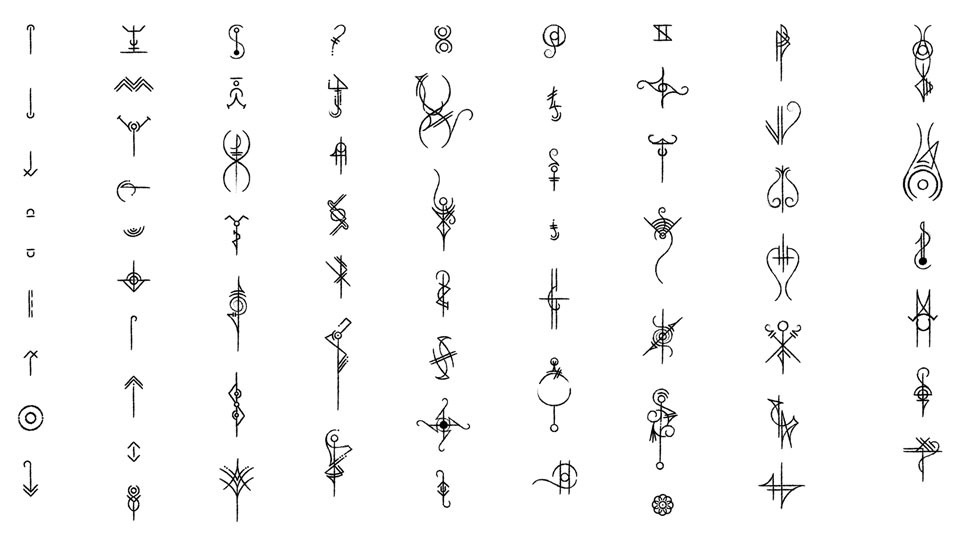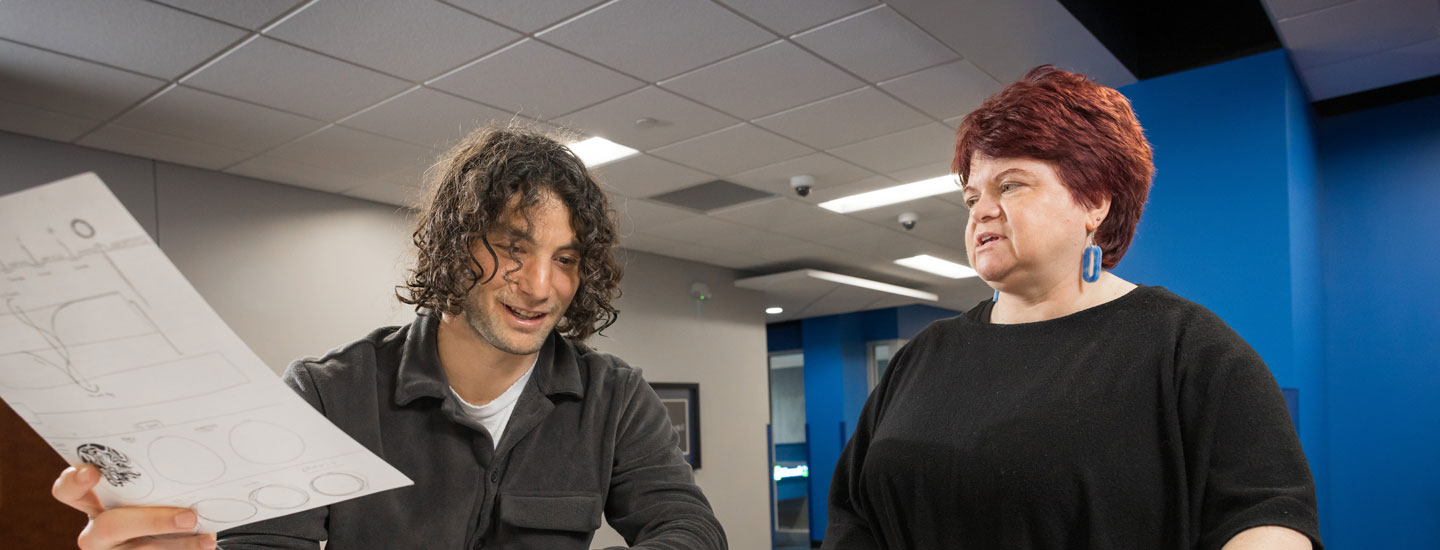Rethinking the keys to meaning
By Julianne Will
Meaning is a complex matter. It incorporates the efforts of both the person trying to convey it and the person receiving it, with all their divergent references, contexts and ways of thinking.
If you ponder it for long, it’s really a wonder that we ever land on shared meaning at all.
Senior Kayra Kargin has spent quite a bit of time thinking about meaning. He’s graduating with a bachelor of science in marketing, but his coursework has included an expansive tour of philosophy and psychology. This served to fan the flames of his natural artistic spark.
And it led him to craft a new way of expression, where complex concepts—such as “details,” “tone,” “curiosity,” “responsibility”—are represented visually, by characters. He refers to this visual expression of meaning as “Keys.”
Under the broader title of “Flementis,” Kayra’s out-of-the-box—and even out-of-the-alphabet—way of thinking unlocks new approaches to the transmission of meaning in applications as diverse as modern art and organizational communications. He’s even writing a book to capture the breadth of his ideas.

But Kayra won’t be the first to tell you about it. Dr.Staci Lugar Brettin, professor of marketing and management and department chair, Marketing and Management at Indiana Tech, uncovered Kayra’s personal passion project in her class.
“He was working on his capstone project for Business Policy and Strategy, and during that time, he took a couple of entrepreneurship courses with me. He was always contributing. He was very engaged, asking intense questions about business models. Kayra was really thoughtful on how we could use business modeling to change the industry,” she says.
“And that’s when I first discovered that he had been working on this project. At that time, the output was not a book. The output was really the process. And so he was trying to figure out, since he was also in my marketing courses, how he could redesign the industry to be so much more innovative.”
A native of Turkey—Kayra came to Indiana Tech as a top student athlete in tennis—he’s found it difficult to secure an internship in advertising, already a competitive field without the challenge of a visa.
“So he wanted to redesign the model of the ad industry where everyone could have an opportunity, almost like open-source design—open source internships,” says Dr. Lugar Brettin. “One of the projects in Entrepreneurial Planning and Growth was that he needed to design some kind of a plan to innovate a business or an industry. So that’s when he coupled his design for this new model with advertising, where everyone learns from everyone else, and they rotate roles. That’s when I really saw him shine.”
Kayra’s vision for a new communications system builds upon itself. While each character can stand on its own as an idea, characters also can be combined to create theories. Kayra’s “Path Theory” is an example; it includes the concepts of ambition, blinded ego, connections, contentment, humblezation, lost, possibilities, unknown, power and curiosity.
And just as each concept in his language system has a character (or symblem, as Kayra calls them—a blend of symbol and emblem), Kayra also has created, with the help of AI, intricate circular drawings for each theory that incorporate all of the characters in that theory. He’s built a website to share his writing and artwork at flementis.net.
Kayra has a wide-ranging vision for the communication system that he’s constructed, including the book that he plans to self-publish in a few months, artwork and a clothing brand.
And with the support of Dr. Lugar Brettin, he’s identified business applications that are as innovative as his communications system.
For business settings, Kayra has visualized a new organizational dynamic in which carefully chosen “sages and visionaries” interact as symbiotic duos to propel a company in innovative directions. Lest ego or power get in the way of their success, “watchers” are tasked with recording the work of the duos for review and ongoing improvement.
The Harmonic Hierarchy Circuit, as Kayra has titled it, includes a number of his symblems as guiding concepts, including compass, proactive, beginner’s mind, connections, humility, transparency and social harmony.
This system could serve as a brainstorming and dynamic exercise during a corporate retreat designed around mission and vision; or a method of identifying new operational procedures and uncovering efficiencies; or even a radical new way of structuring a company that throws the traditional org chart out the window.
After establishing shared meaning within an organization, Kayra says, the company can share that outward with its market. “I think the symblems help to remember the meaning or what the company truly holds, in a way, and that has to start within the company,” he says.
Since childhood, Kayra writes at flementis.net, he’s felt “discontent with our educational systems, which seemed more intent on molding workers for society’s machinery rather than nurturing creators.”
It’s exciting to consider what else might take root within the rich soil of Kayra’s unconventional environment of thinking. But Kayra doesn’t want to make the conversation about him; rather, he prefers to be the pot from which the plant branches, he says.
Indiana Tech has provided the nurturing that Kayra needed to flourish. “Our athletic recruiting is so powerful at Indiana Tech, and it sets us apart,” says Dr. Lugar Brettin. “A lot of times a student will come for athletics and they’ll find their home at Indiana Tech, where they blossom in all the other areas that exist.
“He came because he had this amazing worldview, and he wanted to play and he got a scholarship. But in the classroom, we have the capacity to transform students in a way that a lot of the larger schools cannot,” Dr. Lugar Brettin continues. “So kind of scrapping what I planned for him in that entrepreneurship class and just saying you know what, you’re on a good path, let’s take that forward…that happens in smaller classes, where you’re focused on one student at a time. We really are a special university.”
